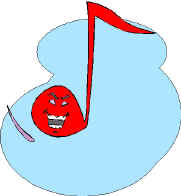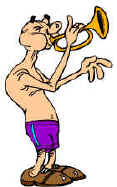

last updated 2/10/2023
D Vautier
Imagine Edison catching musical notes out of the air. What a unbelievable deal. He was sure surprised.
Recorded music does this. It preserves and reproduces air waves generated by an artist or instrument (which is all analog of course). How well the sound gets preserved depends on the quality of the transducer device or, rather, the way the sound can be saved into something permanent. A transducer is any mechanical or electronic tool that can convert airwaves into something else like electronic signals, and these signals need to somehow correspond closely to the actual air waves. The electronic signals then can be saved on some kind of physical media. Originally tinfoil or wax didn't work very well. Later the physical storage techniques improved greatly and rapidly, the first being wiggles on a recording surface, later magnetic charges on a moving plastic length of tape, and finally on bits and bites arranged on a computer.
Just how accurately the sound waves are reproduced and preserved depends on all of these transducer and storage devices and how well they do their job. When you really think about it, our ears are the best and most basic transducer, in fact the only one that really matters. Our ears convert air waves into brain waves. That's the deal!
Over the years the preservation and reproduction of sound has gotten so much better and so have our expectations. As I said, sound started out being saved on wax or tinfoil, then on wire, then cut into shellac cylinders and disks or on a cellulite tape, or on mylar tape, and finally converted to binary code on digital devices.
Initially sound reproduction was considered really great when you listen to the "Frog Song" but by today's standards this was really bad. So as the music novelty became permanent we demanded greater and greater sound quality and gradually we got it. We also demanded transportability and control and we got that too.
Mathematically this is akin to algebraic integration, where, for example, the area under a curve can be calculated precisely by dividing the curved line into a very small number of points and calculating each area between points.
 There
is some discussion of one or the other from purely a listening perspective
but it is a very subjective thing. We don't listen to digital music,
only analog, but somewhere along the chain of microphones, transducers, and
recording equipment, digital processes are unquestionably in there. Digital music
format is
not only a method of
storing music, it is also woven into the fabric of music. Actually nobody stores music much anyway in
analog form because it does not last, but everything that's listened to by our ears
is plain old analog. Digital is
just a really good way to store
the analog and
as such is excellent because it can
be copied forever without loss or as they say, "lossless".
There
is some discussion of one or the other from purely a listening perspective
but it is a very subjective thing. We don't listen to digital music,
only analog, but somewhere along the chain of microphones, transducers, and
recording equipment, digital processes are unquestionably in there. Digital music
format is
not only a method of
storing music, it is also woven into the fabric of music. Actually nobody stores music much anyway in
analog form because it does not last, but everything that's listened to by our ears
is plain old analog. Digital is
just a really good way to store
the analog and
as such is excellent because it can
be copied forever without loss or as they say, "lossless".
In the old days we stored in analog because we had tape recorders. Analog storage could lose information with repeated copy or generation and also deteriorate pretty fast along the way. Analog data storage of any kind is subject to degradation due to age, environment, EM radiation, transfer and use. The real issue is sound quality, which is also a moot argument since anything you hear is analog to begin with and end with but in the middle it's all digital. It has to be. Analog is the way speakers work and the way ears work. Digital is just a good way to store analog, and if used with enough granularity, can be a very efficient, convenient, and inexpensive way to keep sound very true to its analog nature. When played it is converted from a series of digital bits to an electronic signal of fluctuating strength and then run into a transducer device like a speaker that pushes air back and forth so it can effect your ear drums just the way it did when the whole thing started out.
When you digitize sound you are using a physical media, a record, tape, CD or microphone to generate analog electronic signals that run through a transducer or digital conversion or codec device, which converts it and stores it in digital format so it can be later converted back to analog electronic waves which then effect magnets that move diaphragms that move air that move eardrums that stimulate brain waves and recreate the same music that it started out with. Digitally stored music can therefore be listened to over and over without damage or deterioration, and can be copied over and over again also without degradation or signal loss.
Early record companies recorded music on wax with a needle. Later on they used small cutter blades to cut a signal into soft metal masters and this corresponded to the sound wave. After a while engineers began using high quality analog tape. The music was reproduced to vinyl records. The master tapes converted magnetic signals to a cuter blade that inscribed lots of little wiggles on a surface, first shellac later mylar, a very fine type of rubber. The record could be played to produce an analog signal, and by the way, sometimes a very good signal if you have good equipment. LP records are a good media because they can be stored a long time, but every time they are played, some of the little wiggles could get damaged. With good equipment the damage is less but the record will eventually lose some quality. If you play a record once and obtain a good digital signal, you can play the digital media over and over without any quality loss, and still have the original record.
The first vinyl LP records weigh about 200 grams and did not bend much. By about 1970 the later LPs were around 90 grams or so, thinner and quite flexible and used a finer quality of vinyl. I find that the lighter and thinner vinyl records can sound much better. It makes sense. The vinyl rubber is superior quality and can produce more intricate and tighter wiggles. But then the lighter LP is more subject to warping.
Vinyl records probably represent about as close as one can get to the analog experience (other than a live concert), simply because there are fewer transducer devices between the musical air waves and the ear drum, namely three; the high quality speakers, the high end recording tape and the cutter. Of course you have three more transducers on the other end, namely the stylus, amplifier, and speakers. But still it's an analog esperience.
 Of course digital is better than analog
as a storage
media as long as it has sufficient granularity to surpass the "audio
threshold". But lots of audiophiles claim records sound better and
they could be right, after all, it's a perception thing. From my own
point of view, there is no difference
between a played record and it's exact digital copy as long as the equipment
is good enough, the degree of precision in the digital capture is good
enough and
the granularity is good enough to exceed the hearing threshold. That's a lot of
"good enoughs".
But I can always tell when a record is played directly because on quiet
passages there is always some background noise. Life is background
noise.
Of course digital is better than analog
as a storage
media as long as it has sufficient granularity to surpass the "audio
threshold". But lots of audiophiles claim records sound better and
they could be right, after all, it's a perception thing. From my own
point of view, there is no difference
between a played record and it's exact digital copy as long as the equipment
is good enough, the degree of precision in the digital capture is good
enough and
the granularity is good enough to exceed the hearing threshold. That's a lot of
"good enoughs".
But I can always tell when a record is played directly because on quiet
passages there is always some background noise. Life is background
noise.
These are file storage formats for sound like computer languages. What's the issue here? I started out with wav format and I was quite pleased with it. But after some time I had so much music that it became difficult to keep it documented. I switched to MP3 which allows all kinds of documentation; title, artist, album, genre, etc, plus it's smaller in storage size. If you look closely at the 320 KBPS wave form of mp3 compared to the same wav wave form, you can see that the wav contains more granularity. But does that extra depth lie above the hearing threshold?
MP3 is called lossy, which means that if you edit and save it a few times it will begin to lose some quality. If you capture music and do cosmetic editing or just copying MP3 does not degrade.